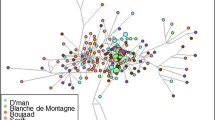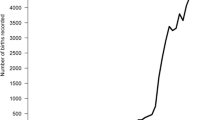Abstract
Genetic structure and genetic diversity levels of indigenous Iranian sheep breeds are not clear, despite the interest this region has in itself as an important center for domestication of livestock. Early population genetic studies have reported high levels of diversity among Iranian sheep breeds until recently, when high admixture levels and genetic homogeneity have been detected. The rapid reduction of diversity observed in Iranian breeds might be due to an increasing trend of intensive crossbreeding practices or even total replacement of native breeds by highly specialized and productive ones. From a conservative perspective, this situation is highly concerning; thus, it might be wise to consider a conservation program in Iran to preserve the original genetic diversity in native sheep breeds. In this study, a total of 1065 animals with the purest morphological features representing 24 Iranian indigenous sheep breeds were sampled, corresponding to ancestral breed diversity. These samples were genotyped for 17 microsatellite loci in order to (1) determine the native ancestral diversity of Iranian breeds, (2) define the degree of genetic relationship among studied breeds, and (3) assess conservation priorities among defined groups. Our results showed no recent loss of diversity, but high genetic diversity levels for indigenous sheep breeds in Iran. Indeed, the analysis of conservation priorities pointed out the importance of 8 breeds for maintaining Iranian sheep breeds’ maximum genetic diversity. Thus, under a genetic perspective, these 8 breeds should be the ones included into conservation programs for restocking endangered areas.


Similar content being viewed by others
References
Allendorf FW, Luikart G (2007) Conservation and the Genetics of Populations. Blacwell Publishing, Malden, MA. ISBN: 978-0-470-67146-7.
Beck L (1986) The Qashqai of Iran. Yale University Press, New Haven, CT. ISBN: 978-0-300-03212-3.
Benjamini Y, Hochberg Y (1995) Controlling the false discovery rate: a practical and powerful approach to multiple testing. Journal of the Royal Statistical Society. Series B (Methodological) 57: 289–300. https://doi.org/10.2307/2346101
Bruk SI, Apenchenko VS (1964) Atlas Narodov Mira [Atlas of the Peoples of the World]. Glavnoe Upravlenie Geodezii I Kartografi, Moscow.
Caballero A & Toro MA (2002) Analysis of genetic diversity for the management of conserved subdivided populations. Conservation Genetics 3: 289–299. https://doi.org/10.1023/A:1019956205473
Caballero A, Rodríguez-Ramilo ST, Ávila V, Fernández J (2010). Management of genetic diversity of subdivided populations in conservation programs. Conservation Genetics 11: 409–419. https://doi.org/10.1007/s10592-009-0020-0
Cañón J, García D, Delgado JV et al (2011) Relative breed contributions to neutral genetic diversity of a comprehensive representation of Iberian native cattle. Animal 5:1323–1334. https://doi.org/10.1017/S1751731111000267
Ćurković M, Ramljak J, Ivanković S et al (2016) The genetic diversity and structure of 18 sheep breeds exposed to isolation and selection. Journal of Animal Breeding and Genetics 133: 71–80. https://doi.org/10.1111/jbg.12160
Dashaba GR, Aslaminejada A, Nassiria M, Esmailizadeh AK, Saghia DA (2011) Analysis of genetic diversity and structure of Baluchi sheep by microsatellite markers. Tropical and Subtropical Agroecosystems 14:1047–1054. Retrieved from: http://scielo.unam.mx/pdf/tsa/v14n3/v14n3a26.pdf
Earl DA, & vonHoldt BM (2012) STRUCTURE HARVESTER: a website and program for visualizing STRUCTURE output and implementing the Evanno method. Conservation Genetics Resources 4:359–361. https://doi.org/10.1007/s12686-011-9548-7
Esmaeilkhanian S, & Banabazi MH (2006) Genetic variation within and between five Iranian sheep populations using microsatellite markers. Pakistan Journal of Biological Sciences 9: 2488–2492. https://doi.org/10.3923/pjbs.2006.2488.2492
Esmaeilkhanian S, Negati-Javaremi A, Afraz F, Daneshyar P, Ghanbari S (2007) Genetic Variation among Baluchi Sheep Population Using Microsatellite Markers. Journal of Science and Technology of Agriculture and Natural Resources 11: 373–380.
Esmailizadeh AK, Nemati M, Mokhtari MS (2012) Fattening performance of purebred and crossbred lambs from fat-tailed Kurdi ewes mated to four Iranian native ram breeds. Tropical Animal Health and Production 44(2):217–23. doi: https://doi.org/10.1007/s11250-011-0001-4.
Evanno G, Regnaut S, Goudet J (2005) Detecting the number of clusters of individuals using the software STRUCTURE: a simulation study. Molecular Ecology 14: 2611–2620. https://doi.org/10.1111/j.1365-294X.2005.02553.x
FAO (2011) Guidelines for the Molecular Genetic Characterization of Animal Genetic Resources. FAO, Rome, Italy.
Goudet J (2001) FSTAT: A Program to Estimate and Test Gene Diversities and Fixation Indices, version 2.9.3. Lausanne University, Lausanne, Switzerland. Retrieved from: https://www2.unil.ch/popgen/softwares/fstat.htm
Iranian Ministry of Agriculture (2012) Statistically yearbook 91 (In Persian). Retrieved from: http://www.maj.ir/
Iranpur M, Esmailizadeh A (2010) Rapid Extraction of High Quality DNA from Whole Blood Stored at 4°C for Long Period. Protocol online Retrieved from: http://www.protocol-online.org/prot/Protocols/Rapid-Extraction-of-High-Quality-DNA-from-Whole-Blood-Stored-at-4-C-for-Long-Period-4175.html
Kantanen J, Olsaker I, Holm LE et al (2000) Genetic diversity and population structure of 20 North European cattle breeds. Journal of Heredity 91: 446–457. https://doi.org/10.1093/jhered/91.6.446
Karimi K, Strucken EM, Moghaddar N, Ferdosi MH, Esmailizadeh A, Gondro C (2016) Local and global patterns of admixture and population structure in Iranian native cattle. BMC Genetics, 17, 108. https://doi.org/10.1186/s12863-016-0416-z
Kijas JW, Townley D, Dalrymple BP et al (2009) A genome wide survey of SNP variation reveals the genetic structure of sheep breeds. PLoS ONE 4: e4668. https://doi.org/10.1371/journal.pone.0004668
Kirkpatrick S, Gelatt CD, Vecchi MP (1983) Optimization by simulated annealing. Science 220: 671–680. https://doi.org/10.1126/science.220.4598.671
Kopelman NM, Mayzel J, Jakobsson M, Rosenberg NA, Mayrose I (2015) Clumpak: a program for identifying clustering modes and packaging population structure inferences across K. Molecular Ecology Resources 15: 1179–1191. https://doi.org/10.1111/1755-0998.12387
Molaee V, Osfoori R, Eskandari Nasab MP Qanbari S. (2009). Genetic relationships among six Iranian indigenous sheep populations based on microsatellite analysis. Small Ruminant Research 84: 121–124. https://doi.org/10.1016/j.smallrumres.2009.05.004
Nanekarani S, Amirinia C, Amirmozafari N, Torshizi RV, & Gharahdaghi AA. (2010) Genetic variation among pelt sheep population using microsatellite markers. African Journal of Biotechnology 9:7437–7445. https://doi.org/10.5897/AJB10.656
Pérez-Figueroa A, Saura M, Fernández J, Toro MA Caballero A (2009) METAPOP—a Conservation Genetics 10: 1097–1099. https://doi.org/10.1007/s10592-008-9718-7
Pike N (2011) Using false discovery rates for multiple comparisons in ecology and evolution. Methods in Ecology and Evolution 2: 278–282. https://doi.org/10.1111/j.2041-210X.2010.00061.x
Pritchard JK, Stephens M, Donnelly P (2000) Inference of population structure using multilocus genotype data. Genetics 155: 945–959.
Rousset F (2008) Genepop’007: a complete reimplementation of the Genepop software for Windows and Linux. Molecular Ecology Resources 8: 103–106. https://doi.org/10.1111/j.1471-8286.2007.01931.x
Seidani ES, Amirinia C, Lavaf A, Farasati C, Aminafshar M (2009) Genetic variation among different ecotypes of the Iranian Sanjabi sheep. Journal of Animal and Veterinary Advances 8: 1173–1176. Retrieved from: http://www.medwelljournals.com/abstract/?doi=javaa.2009.1173.1176
Soma P, Kotze A, Grobler JP, van Wyk JB (2012) South African sheep breeds: population genetic structure and conservation implications. Small Ruminant Research 103:112–119. https://doi.org/10.1016/j.smallrumres.2011.09.041
Tavakolian J (2000) An Introduction to Genetic Resources of Native Farm Animals in Iran. Animal Science Genetic Research Institute Press, Tehran, Iran (in Persian).
Vahidi SM, Faruque MO, Falahati Anbaran M et al (2016) Multilocus genotypic data reveal high genetic diversity and low population genetic structure of Iranian indigenous sheep. Animal Genetics 47: 463–470. https://doi.org/10.1111/age.12429
Vajed Ebrahimi MT, Mohammadabadi M, Esmailizadeh A (2017) Using microsatellite markers to analyze genetic diversity in 14 sheep types in Iran. Archives Animal Breeding 60:183–189. https://doi.org/10.5194/aab-60-183-2017
Van Oosterhout C, Hutchinson WF, Wills DPM, Shipley P (2004) Micro-checker: software for identifying and correcting genotyping errors in microsatellite data. Molecular Ecology Notes, 4, 535–538. https://doi.org/10.1111/j.1471-8286.2004.00684.x
Zahedi Z, Esmaeelkhanian S, Vaez Torshizi R (2007) Microsatellite variation in one breed of Iranian sheep with 12 markers. Pakistan Journal of Biological Sciences 10: 4455–4460. https://doi.org/10.3923/pjbs.2006.2488.2492
Zeder MA (2008) Domestication and early agriculture in the Mediterranean Basin: Origins, diffusion, and impact. Proceedings of the National Academy of Sciences USA 33:11597–11604. https://doi.org/10.1073/pnas.0801317105
Acknowledgments
The authors thank the Sequencing and Genotyping Facilities of SGIker of UPV/EHU for providing technical and human support. Research center of specific livestock, University of Zabol, Iran, and National Animal Breeding and Animal Products Promotion Center in Iran are acknowledged for their kind cooperation in our sampling efforts. This work would not have been possible without the participation of numerous Iranian flock holders who helped us in sheep sample collection.
Author information
Authors and Affiliations
Corresponding author
Ethics declarations
Conflict of interest
The authors declare that they have no conflict of interest.
Additional information
Publisher’s note
Springer Nature remains neutral with regard to jurisdictional claims in published maps and institutional affiliations.
Rights and permissions
About this article
Cite this article
Ruiz-Larrañaga, O., Asadollahpour Nanaei, H., Montes, I. et al. Genetic structure of Iranian indigenous sheep breeds: insights for conservation. Trop Anim Health Prod 52, 2283–2290 (2020). https://doi.org/10.1007/s11250-020-02252-3
Received:
Accepted:
Published:
Issue Date:
DOI: https://doi.org/10.1007/s11250-020-02252-3




